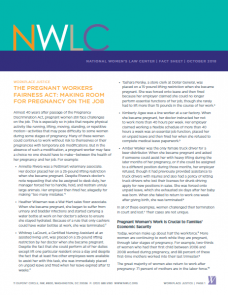Abortion rights, women of color, and LGBTQI+ people are under attack. Pledge to join us in fighting for gender justice.

 More than 40 years after passage of the Pregnancy Discrimination Act, pregnant women still face challenges on the job. This is especially so in jobs that require physical activity like running, lifting, moving, standing, or repetitive motion—activities that may pose difficulty to some women during some stages of pregnancy. Many of these women could continue to work without risk to themselves or their pregnancies with temporary job modifications. But in the absence of such a modification, a pregnant worker may face a choice no one should have to make—between the health of her pregnancy and her job. For example:
More than 40 years after passage of the Pregnancy Discrimination Act, pregnant women still face challenges on the job. This is especially so in jobs that require physical activity like running, lifting, moving, standing, or repetitive motion—activities that may pose difficulty to some women during some stages of pregnancy. Many of these women could continue to work without risk to themselves or their pregnancies with temporary job modifications. But in the absence of such a modification, a pregnant worker may face a choice no one should have to make—between the health of her pregnancy and her job. For example:
- Annette Rivera was a PetSmart veterinary associate. Her doctor placed her on a 25-pound lifting restriction when she became pregnant. Despite Rivera’s doctor’s note requesting that she be assigned to desk duty, her manager forced her to handle, hold, and restrain unruly large animals. Her employer then fired her, allegedly for making “too many mistakes.”
- Heather Wiseman was a Wal-Mart sales floor associate. When she became pregnant, she began to suffer from urinary and bladder infections and started carrying a water bottle at work on her doctor’s advice to ensure she stayed hydrated. Because of a rule that only cashiers could have water bottles at work, she was terminated.
- Whitney LaCount, a Certified Nursing Assistant at an assisted living unit, was placed on a 25-pound lifting restriction by her doctor when she became pregnant. Despite the fact that she could perform all of her duties except lift one particular resident once a day and despite the fact that at least five other employees were available to assist her with this task, she was immediately placed on unpaid leave and fired when her leave expired after 12 weeks.
- Tashara Persky, a store clerk at Dollar General, was placed on a 15-pound lifting restriction when she became pregnant. She was forced onto leave and then fired because her employer claimed she could no longer perform essential functions of her job, though she rarely had to lift more than 15 pounds in the course of her work.
- Kimberly Agee was a line worker at a car factory. When she became pregnant, her doctor instructed her not to work more than 40 hours per week. Her employer claimed working a flexible schedule of more than 40 hours a week was an essential job function, placed her on unpaid leave and then fired her when she refused to complete medical leave paperwork.
- Amber Walker was the only female truck driver for a beer distributor. When she became pregnant and asked if someone could assist her with heavy lifting during the later months of her pregnancy, or if she could be assigned to a different position during those months, her employer refused, though it had previously provided assistance to truck drivers with injuries and also had a policy of letting truck drivers who lost their licenses for drunk driving apply for new positions in sales. She was forced onto unpaid leave, which she exhausted six days after her baby was born. When she failed to return to work one week after giving birth, she was terminated.
In all of these examples, women challenged their termination in court and lost. Their cases are not unique.
Pregnant Women’s Work Is Crucial to Families’ Economic Security
Today, women make up about half the workforce. More women are continuing to work while they are pregnant, through later stages of pregnancy. For example, two-thirds of women who had their first child between 2006 and 2008 worked during pregnancy, and 88 percent of these first-time mothers worked into their last trimester.
The great majority of women also return to work after pregnancy: 71 percent of mothers are in the labor force. In 2015, 42 percent of working mothers were their family’s primary breadwinner and nearly another one-quarter of mothers were co-breadwinners. Because preparing for a new baby means preparing for increased expenses, a woman’s wages will often be particularly important to her family when she is pregnant.
Mismatch between job duties and the demands of pregnancy tends to take a particular toll on low-income women, who are more likely to work in jobs that offer limited flexibility. It also harms women in relatively high-paying, physically demanding jobs traditionally held by men, such as trucking or policing—jobs that already are often particularly difficult for women to enter. And for the five to eight percent of pregnant women experiencing intimate partner violence, such mismatch undermines the economic independence that is critical to escaping a violent relationship. When women face a physical conflict between work and childbearing, they will often lose their job, and their families will lose income at the very moment their financial needs increase.
The Legal Landscape for Pregnant Workers
Before Congress passed the Pregnancy Discrimination Act of 1978 (PDA), it was common for employers to categorically exclude pregnant women from the workforce. The PDA changed this forever by guaranteeing the right not to be treated adversely because of pregnancy, childbirth, or related medical conditions, and the right to be treated at least as well as other employees “not so affected but similar in their ability or inability to work.”
Unfortunately, many courts interpreted the PDA narrowly and allowed employers to refuse to accommodate workers with medical needs arising out of pregnancy even when they routinely accommodated other physical limitations. In Young v. UPS, the Supreme Court held that when an employer accommodates workers who are similar to pregnant workers in their ability to work, it cannot refuse to accommodate pregnant workers who need it simply because it “is more expensive or less convenient” to accommodate pregnant women too. The Court also held that an employer that fails to accommodate pregnant workers violates the PDA when its accommodation policies impose a “significant burden” on pregnant workers that outweighs any justification the employer offers for those policies. The Young decision was an important victory for pregnant workers, but the multi-step balancing test it set out still left many important questions unanswered and created uncertainty about when exactly the PDA requires pregnancy accommodations.
In addition, the Americans with Disabilities Act (ADA) requires employers to make reasonable accommodations for employees with disabilities. However, courts have consistently held that ordinary pregnancy is not a disability.
The Pregnant Workers Fairness Act Strengthens and Affirms Protections for Pregnant Workers
The Pregnant Workers Fairness Act (PWFA) (H.R. 1065/S. 1486) would answer the questions left open by the Supreme Court by setting out a simple, easy-to-apply legal standard that would provide clarity for employers and employees alike. The PWFA would let pregnant women continue to do their jobs and support their families by requiring employers to make the same sorts of accommodations for pregnancy, childbirth, and related medical conditions that the ADA requires employers to make for disabilities.
- The PWFA would require employers to make reasonable accommodations for employees who have limitations stemming from pregnancy, childbirth, or related medical conditions, unless the accommodation would impose an undue hardship on the employer. For example:
- An employer might be required to modify a no-food-or-drink policy for a pregnant employee who experiences painful or potentially dangerous uterine contractions when she does not regularly drink water.
- An employer might be required to provide a stool to a pregnant cashier who was experiencing leg pain and swelling from standing for long periods of time.
- An employer might be required to reassign heavy lifting duties to other employees for some portion of an employee’s pregnancy.
- An employer might be required to provide an available light duty position to a pregnant police officer who was temporarily unable to go on patrol because no bulletproof vest would fit her.
- The PWFA would prohibit employers from discriminating against employees because they need this sort of reasonable accommodation. In other words, an employer would not be allowed to fire a pregnant employee to avoid making any job modifications, or to retaliate against an employee who had asked for an accommodation.
- The PWFA would prohibit employers from forcing a pregnant employee to take paid or unpaid leave when another reasonable accommodation would allow the employee to continue to work. While the employee would remain free to choose to use any leave available to her, she would not be forced off the job and onto leave against her will.
The PWFA relies on a reasonable accommodation framework already familiar to employers accustomed to the ADA’s requirements. It would provide real solutions to those workers currently being asked to choose between their pregnancy and their paycheck.

